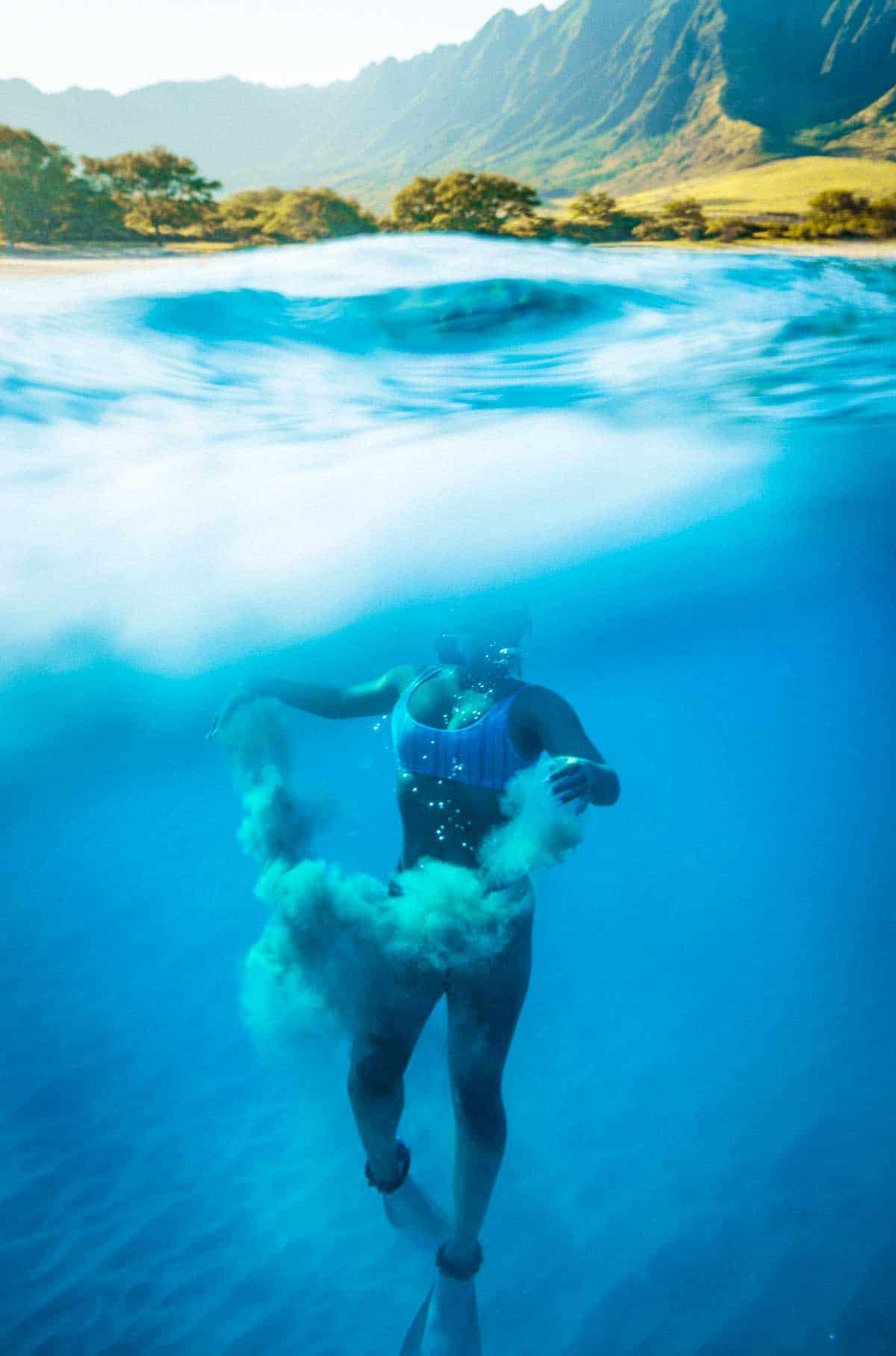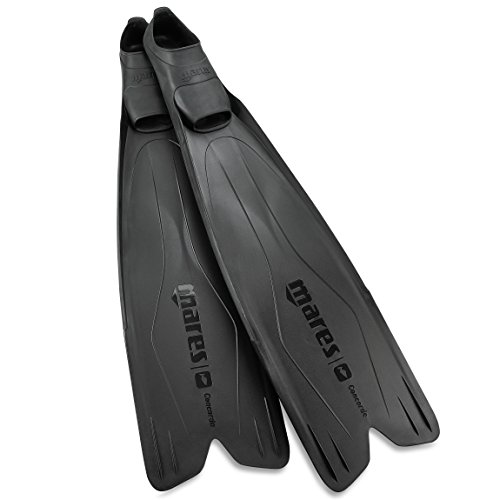You might have started freediving with snorkeling or scuba diving fins, but as you progress with freediving chances are you’ll notice experienced freedivers using much longer fins. And if you’ve decided to invest in a pair, then we’re here to help you decide which ones to buy. Below are some things to consider before parting with your cash. The Buyer’s Guide and Frequently Asked Questions will help you understand the different materials, styles, and features available so you can choose which will work best for you. We’ve reviewed the ten best freediving fins with an overview of the features and styles available from a variety of manufacturers.
ALL THE FREEDIVING FINS THAT WE TESTED
OMER Stingray EVO
General Impression
The Omer Stingray EVO are high-quality fins for freediving and spearfishing. Featuring long, 22-degree downwards, medium flex blades makes it quite the popular solution for comfortable diving. Coming in with stingray foot pockets and in a brand new color, the Stingray EVO is perfect for camouflaging while exploring rocky or sandy seabeds. The keyhole ensures ultimate performance and minimizes the kicking force.
Specifications
SIZE: 35/36
WEIGHT: 3.6 lbs
BLADE: Paddle, no channels
FOOT POCKET: Full Foot
MATERIAL: Polymer plastic
PROS
- Easy gliding
- Comfortable
- Detachable parts
CONS
- None
CRESSI Gara Professional
General Impression
An entry-level long fin, that is specially designed to be free diving fins, and spearfishing fins. The long blades provide maximum thrust for minimal effort, adding to the enjoyment and satisfaction of the diver. This model of Cressi freediving fins is also used by many world-class freediving competitors, as it has a reputation for excellence.
Specifications
SIZE: 44908
WEIGHT: 6.6 lbs – Entire package
BLADE: Paddle, no channels
FOOT POCKET: Full foot
MATERIAL: Polymer plastic
PROS
- It is an excellent choice for new divers, also available in a starter-kit with snorkel and mask.
- Great for those wishing to build leg strength
- Sound choice for those looking for more traditional style and functionality.
- The best spearfishing fins around
CONS
- Fin does not emit the force evenly
LEADERFINS Pure Carbon
General Impression
Constructed with a high-quality mix of carbon fiber, fiberglass, and epoxy resin, these LEADERFINS are the best carbon fiber freediving fins around.A massive 95cm long blade that’s angled at an optimum 22-degrees, all help you move through the water smoother than a fish.
Specifications
SIZE: 44877
WEIGHT: 4.8 lbs
BLADE: Paddle with channels
FOOT POCKET: Full foot
MATERIAL: Carbon Fibre and fiberglass
PROS
- Variable stiffness of blades
- Soft EDPM rubber foot pocket
- The ideal carbon fiber fins for spearfishing and freediving.
CONS
- Fins crack easily when not looked after
MARES Concorde
General Impression
This is the upgraded version of the popular original MARES freediving flippers. The original version is suited to shallow – mid-level diving, with the newer version going to greater depths, due to its fixed polymer blade. The unique fish-tail tip gives improved efficiency and prevents the fins from wobbling during fining.
Specifications
SIZE: 8.5-9
WEIGHT: 2 lbs
BLADE: Paddle with channels
FOOT POCKET: Full foot
MATERIAL: Polymer plastic
PROS
- These freedive fins have a special fish-tail/V fin-tip for improved energy and stability during fining.
- This model of MARES freediving fins also has notches on both sides of the blade to help channel water away from the blade, giving greater energy transference.
CONS
- Sizing inconsistent
MAKO Competition Freediver
General Impression
Are you wanting to level up your freediving? Then these MAKO fins are the key to your success. Not your traditional plastic-blade fins, these bent blades are formed from 90% Borealis and 10% fiberglass, making them the best MAKO freediving fins available.
Specifications
SIZE: 44782
WEIGHT: 4.2 lbs
BLADE: Removable blade
FOOT POCKET: Full foot
MATERIAL: Polymer plastic
PROS
- The foot pockets are made with diving in mind; stiff where support is needed, flexible for maximum performance.
- These MAKO foot pockets also fit a wide range of bent (angled) blades, making the Competition model even more versatile for both freedive fins and spearfishing flippers.
CONS
- Sizing inconsistent
CRESSI Gara 3000
General Impression
With a full foot pocket design and CRESSI’s unique three material molding process, the Gara 3000 offers superior comfort and durability to both beginner freedivers, and those looking for long-duration dives.
Specifications
SIZE: 9.5/10
WEIGHT: 4 lbs
BLADE: Paddle, flexible
FOOT POCKET: Full foot
MATERIAL: Polymer plastic
PROS
- Softer blade design means less muscle effort is needed when fining, making these fins ideal for new freedivers.
- These fins are also the perfect choice for freedivers wanting to extend their dive duration or those prone towards leg fatigue.
CONS
- Very long fins
OMER SPORASUB Spitfire
General Impression
Getting serious about your spearfishing? The SPORASUB Spitfire will have you diving deeper for longer, chasing those elusive prize fish. Constructed from thermo-rubber, with two hardness levels, the Spitfire is the best spearfishing fin in this range.
Specifications
SIZE: 8.5/9
WEIGHT: 5.5 lbs
BLADE: Paddle with channels
FOOT POCKET: Full foot
MATERIAL: Polymer plastic
PROS
- Two-tone foot pocket, anti-slip patterned heel, and a detachable blade for greater fin variety and servicing options. The Spitfire is the perfect spearfishing fin available.
CONS
- Slightly unnatural handle
- No handle locking mechanism
SEAC Motus
General Impression
These SEAC freediving fins are a perfect choice for divers looking for affordability and versatility in the best freediving fins for spearfishing. With a specially designed combination of thermoplastic rubber sole and ribs, along with a softer foot pocket, these free fins are fully optimized for maximum thrust.
Specifications
SIZE: 44814
WEIGHT: 4.5 lbs
BLADE: Interchangeable blade
FOOT POCKET: Full foot
MATERIAL: Polymer plastic
PROS
- 22-degree blade angle
- Edged rails that helps disperse water away from the fin
- Large heel pull-tab for smoother suiting/removal of the fins.
CONS
- Cracks easily if not looked after
MARES Pure Instinct
General Impression
As with many MARES fins, the Pure Instinct freediving fins are modeled after the successful Razor design. Incorporating a 22-degree angled blade, and a foot pocket that follows as a natural extension of the leg, this fin gives the diver maximum thrust with each kick.
Specifications
SIZE: 44750
WEIGHT: 2.2 lbs
BLADE: Interchangeable blades,
FOOT POCKET: Full foot
MATERIAL: Polymer plastic
PROS
- Blades that vary in thickness to bend as needed during fining.
- Lateral stringers on the foot pocket to increase the flow of water towards the tip.
- The lightweight and powerful design make it ideal for spearfishing.
CONS
- Sizing inconsistent
MARES Razor Matrix
General Impression
The lightest and strongest of our freediving fins review, the MARES Razor Matrix really is the optimum blend of technology and soul. Encompassing traditional styling and design, with a full foot pocket and combination carbon fiber and fiberglass blade, it is the best freediving fins around.
Specifications
SIZE: 44845
WEIGHT: 1 lb
BLADE: Carbon fiber and fiberglass, channels and fish-tail V
FOOT POCKET: Full foot, w/3mm sock
MATERIAL: Fiberglass and Carbon Fibre
PROS
- 22-degree blade inclination
- Optimized channel flex and thrust
- Variable blade thickness and parabolic flexion.
- High-quality manufacturing process from an industry leader to bring you the highest quality freediving fins.
CONS
- None
BEST FREEDIVING FINS
Buyer's Guide
Thinking about getting yourself a new pair of freediving fins? Or perhaps you’re shopping for a present for the freediver in your family, and want to know what to look for and how to choose the right fins.
To help you make that choice we’ve written this handy freediving fin review and buyers’ guide, and in this section, we’ll be focusing on 6 critical areas you should know about before making any purchase.
Skill Level
Let’s be honest, this is the first question you should be asking yourself and it’s the one only you (or the diver you’re buying for) can answer, so be honest. Seriously consider your freediving experience, your understanding of the sport, and what you’re capable of achieving on any given dive.
Sadly, it’s not uncommon for divers to overrate their abilities; usually to keep up with peers and dive buddies, which is understandable but can also be deadly. Instead, you’re better off considering how much use your fins will be getting; are you a regular or irregular freediver?
If you want to seriously improve your diving abilities, then looking for fins that are going to be able to change as you develop. Fins with interchangeable blades are an ideal solution here. With interchangeable bladed fins, you can start freediving and be fully comfortable with them knowing they fit you perfectly, and that only the blades will change over time as you develop as a diver.
Another point for beginner divers is to choose a material and make that won’t break the bank. After all, you don’t want to spend up only to find the sport is not for you, or that they’re too uncomfortable to use. In this case, look for fins that are made of polymer plastic, they’ll be inexpensive and readily available, often in a range of colors and styles.
For more advanced freedivers, consider fiberglass or carbon fiber fins, or a composite of both. These fins will give you greater depth development and a smoother kick for optimal dive duration.
Material
Not all fins are made of the same stuff, and there are horses for courses. Currently, fins are made from three different materials, each has benefits and also downsides, and your choice should be made based on experience, budget, and how much diving you’ll be doing.
When it comes time to make the big purchase, you’ll see the following labels used to identify what your potential fins are made from:
Polymer plastic – recommended for new divers
Fiberglass or carbon fiber – best suited to experienced freedivers, or those wishing to make significant improvements once a suitable level of experience has been gained.
Polymer Plastic
Affordable, durable and practical, this is the material most beginner divers will become familiar with as their first freediving fins. Is it only for beginners? Not at all, many experienced freedivers prefer these fins.
What’s great about it? It has a good amount of flexibility and is affordable for every bank balance, it’s also the most common so you’ll never have to worry about standing out as the new kid on the block.
If you’re thinking about fins for travel, then fins made from polymer plastic are the best choice. They’ll easily survive the journey; you won’t have to worry about bumps, scratches or rough treatment.
Sadly, the downside of this material is its longevity; they won’t last forever. The technology used in polymer plastic means it has a type of memory that conforms into a curved shape, kind of like some scuba diving fins, and it will make them inefficient to use and a little uncomfortable too.
Fiberglass
Fiberglass is the middle child of this family, it lacks the finesse of carbon, but can match the duration and rough use (to some extent) of polymer plastic. It is more expensive than the entry-level plastic, but it does a better job at holding its shape over time. Another benefit is its weight, being substantially less than polymer plastic, and it is often incorporated into blades for additional strength and stiffness.
Carbon Fiber
The most expensive of all the fin types, and it is best suited to advanced freedivers, or those into competitions on a semi-professional level and up. Carbon fiber is significantly more efficient than other material types, in how it uses the energy of your fin-kicks. It’s this efficiency that guarantees the greatest transference of force into propulsion, ensuring you make the most of every single kick.
Another great benefit of carbon fiber is its weight or lack thereof. It’s incredibly light, which is a big attraction for professional freedivers. Unfortunately, this type of fin is not as robust as polymer plastic or even fiberglass. Due to its inherent properties, this type of fin is rather fragile and can be easily damaged in transport, or on rough surfaces.
On the upside, however, they do not form any memory during use, so they will remain usable for many years, as they’ll retain their stiffness and straightness no matter how many dives you do.
Budget
It’s one area we’re all victim of, and wish we had more than we do. So, where do you start? A good guide for any important purchase is to always buy the best you can afford – this includes value for money, quality workmanship, and excellent customer service. Buying any type of freediving fins is an investment in your sport, but also in your safety and happiness, so to avoid disappointment and disaster, don’t be a cheapskate!
Freediving fins will range in price dramatically. Polymer plastic fins are available for the price of a nice meal out with your loved one. Fiberglass might set you back the monthly phone and internet budget, and for the top of the line carbon fiber, you can expect to hand over the monthly grocery amount. That is to say, fins can range from under $100 into several hundreds of dollars, all depending on brand, material, size, and style.
Just remember, be honest and realistic about your diving, how much you do, and what your goals and ambitions are, and of course, what you can reasonably afford. If you’re looking for a bit more guidance, a great YouTube video here is highly recommended.
Focus On Fit
Go on, put your foot in it. No, I don’t mean embarrass yourself, but do try them on before buying! Never buy fins sight-unseen, this way disappointment leads. That’s harder to do when shopping online, so if possible see if your local dive store can help you out with some in-store advice.
Another point to remember is that manufacturers can be generous in their sizing guides, so it’s best to try on a similar model by the same maker if possible. You should also check whether or not your potential fin requires a neoprene sock or can be worn barefoot, as this will impact the overall fit and comfort level of your new fins.
Foot Pockets And Blade
Freediving fins don’t just come as a one-piece set, some fins have detachable blades that can be customized for stiffness and length.
This option is a great one if you’re dedicated to achieving your freediving goals, and don’t mind the added expense. You will be able to combine different brands and sizes making it ideal for getting the best fit possible.
Stiffness
All jokes aside, the stiffness of your fins can seriously affect your dive. Depending on your body shape, height, and amount of musculature together with dive experience. Divers who have longer legs, generally, produce less force so a stiffer blade is a good choice, but if you have short legs, then you want a flexible blade. As a general guide, all divers will benefit from a medium-stiffness blade and should only alter this if experienced enough to make that call.
BEST FREEDIVING FINS
FAQs
1. What is the difference between freediving fins, scuba diving fins, and snorkeling fins?
The short answer is length. But that would also be misleading, as it’s what a layperson would notice. Whilst freediving, snorkeling, and scuba diving fins all share similarities, they are also designed with specific functions in mind.
A freediving fin is the longest of the three, it is usually also the lightest weight, as it is designed to carry the diver through water uninhibited to depths experienced by scuba divers.
Snorkeling and scuba diving fins also tend to be a medium stiffness and shorter, as they are designed not to provide quite as much ‘kick’, as neither snorkeling nor scuba diving is time-critical. Freediving, as you know, is done using the breath in your lungs, so being time/energy efficient is of the highest order. Because freediving fins are stiffer they give the diver greater speed for minimal effort, thus making the most of the time available.
2. Why are freediving fins so long?
Time and energy, it’s a critical equation, and longer fins give the diver the best results. By using longer and stiffer fins, a freediver can achieve deeper dives over a longer duration. Shorter and more flexible fins, like those used in snorkeling and scuba, would significantly reduce that duration.
3. How to use freediving fins?
There are many how-to manuals on freediving, and the manufacturer of your fins will include one with your fins.
As a general rule of thumb try this approach: kick your freedive fins from your hips to your toes, keeping your legs straight. A bend in your leg will cause unnecessary motion that will cost you loss of air – a major problem when freediving.
4. What are the best freediving fins?
This is a deeply personal question and will change from one diver to the next depending on their skill and experience, and of course their budget. As with anything in life, look for the best value for money products to suit your particular needs and ambitions. Things to consider could include; foot pocket style, fin rigidity, materials used, design benefits, weight, length, and the obvious one, cost.
5. Can you use freediving fins for scuba diving?
Yes and no. If it was a matter of life and death, you could use them, but there are certain risks in using freediving fins for scuba diving. One such risk is their stiffness and entries; giant-strides, for instance, could break your freediving fins as they are not designed to deal with this type of impact.
Another risk is due to their length, in wreck diving these could become entangled and cause an accident. However, for scuba divers who enjoy open water scenic dives have reported great results using freediving fins, as they have prolonged dive length due to reducing air consumption.
6. Can you use freediving fins for snorkeling?
As with scuba diving, yes and no. Due to snorkeling taking place at the water’s surface, this makes freediving fins, not the best choice, as they’re designed to move large amounts of water and not be as maneuverable. Snorkeling requires the swimmer to be able to make quick turns and varied shallow dives, freediving fins do not allow for this as they are designed for a more one-directional movement.
REACH OUT
As always, we create our content with you, fellow adventurers, in mind. So, how’d we do? Did you find this informative? Did it help you make a decision? Did we miss anything? We’d love to hear from you below. Thanks for reading and we hope your next adventure is a great one!














































